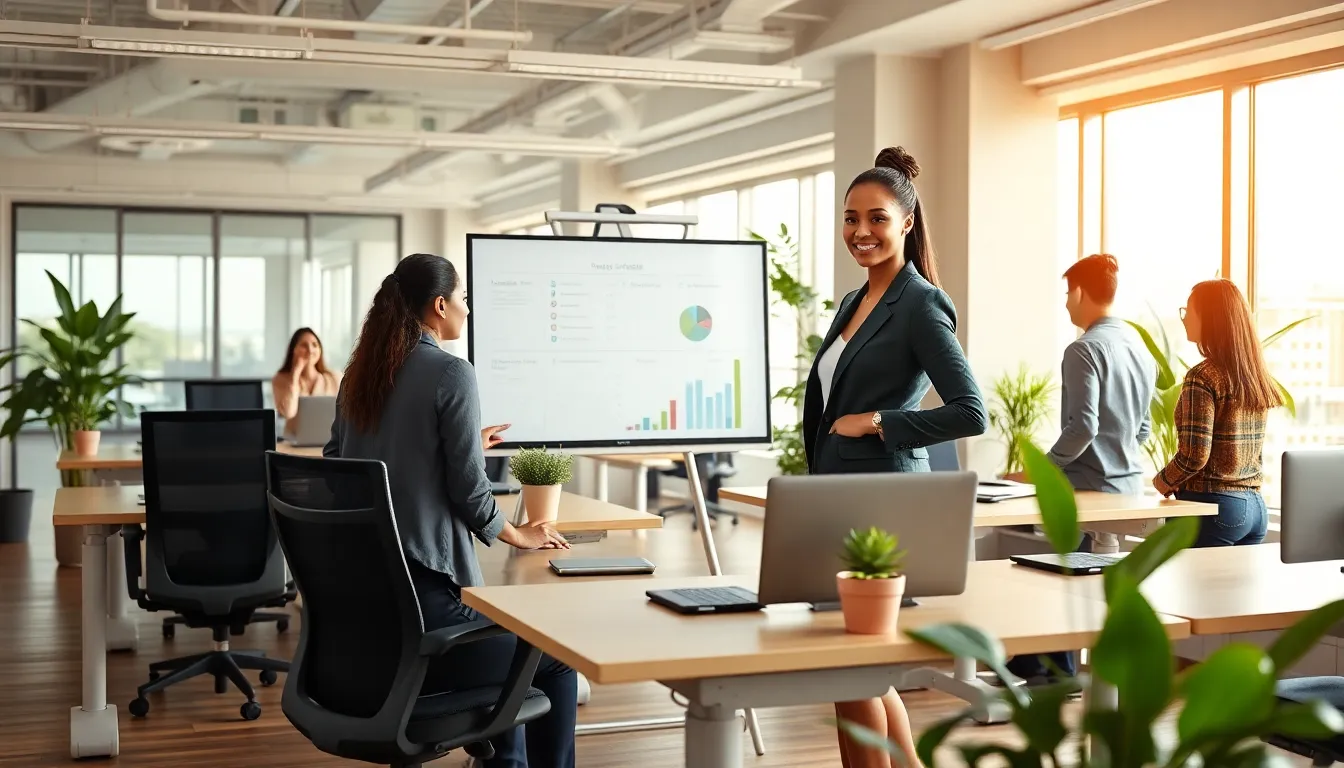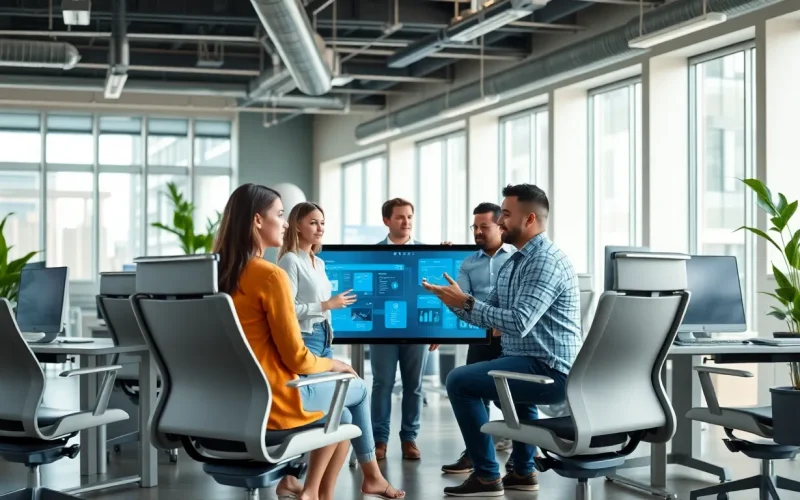Table of Contents
ToggleIn today’s fast-paced world, the high-tech office isn’t just a luxury; it’s a necessity. Imagine walking into a workspace where coffee brews itself, screens adjust to your eye level, and your chair practically gives you a massage. Sounds like a dream? Welcome to the future of work, where innovation meets comfort in a delightful dance of productivity.
Gone are the days of clunky equipment and endless paperwork. The high-tech office promises not only efficiency but also a sprinkle of fun. With smart gadgets, seamless connectivity, and tools like an AI presentation maker to save time, employees can focus on what really matters—like finally beating that high score on the office’s favorite game. Embracing this tech-savvy approach can transform a mundane workday into an exhilarating experience, boosting morale and creativity. So, let’s dive into the world of high-tech offices and discover how they can revolutionize the way we work.
Overview of High-Tech Offices
High-tech offices represent the next generation of workspaces, integrating advanced technology to foster productivity and collaboration. These environments utilize smart technology, including artificial intelligence, to streamline operations and manage tasks efficiently. Features like automated lighting and climate control adapt to employee needs, promoting comfort throughout the day.
Flexible workstations comprise adjustable desks and versatile meeting rooms, allowing for a fluid workflow. Employees can shift from collaborative areas to private spaces seamlessly, accommodating various work styles. Digital interfaces enhance communication, connecting teams through intuitive platforms designed for sharing information quickly.
Robust connectivity plays a pivotal role in high-tech offices. High-speed internet and cloud solutions ensure easy access to essential resources anytime, anywhere. Noise-canceling features in open office layouts create focused work zones, balancing social interaction with concentration.
Ergonomic furniture supports physical well-being, reducing strain during long hours at work. Employees can benefit significantly from this emphasis on health, positively impacting overall morale and performance.
Innovative productivity tools contribute to collaboration. Technologies such as virtual reality and interactive displays facilitate brainstorming sessions, making idea sharing dynamic and engaging. Future trends indicate an increasing reliance on these tools, further shaping the high-tech office landscape.
Businesses adopting high-tech elements demonstrate adaptability in a competitive marketplace. They reflect a commitment to creating environments that prioritize employee needs and well-being. The shift towards these high-tech spaces reflects a broader transformation in workplace culture and employee engagement strategies.
Key Features of High-Tech Offices

High-tech offices incorporate various cutting-edge technologies that enhance productivity and facilitate a modern work environment. These features cater to employees’ needs and promote overall well-being.
Smart Technology Integration
Smart technology facilitates seamless operations in high-tech offices. Automated systems manage lighting, temperature, and even security, ensuring environments adapt to employee preferences. Artificial intelligence streamlines workflow by assisting with scheduling and task management. Devices like smart whiteboards and virtual assistants elevate collaboration, making teamwork more efficient. Connectivity plays a crucial role in this integration; employees access cloud services and communication tools effortlessly, enhancing real-time interaction.
Ergonomic Design
Ergonomic design features are crucial in high-tech offices, promoting comfort and productivity. Adjustable desks accommodate standing or sitting positions, allowing employees to choose their preferred work style. Ergonomically designed chairs support proper posture, reducing the risk of injury during long work hours. Enhancements like keyboard trays and monitor risers ensure equipment aligns with individual needs, fostering a healthier workspace. Consequently, these design choices contribute to higher employee satisfaction and improved focus throughout the day.
Sustainable Practices
Sustainable practices are increasingly common in high-tech offices, reflecting a commitment to environmental responsibility. Energy-efficient lighting, such as LED options, reduces power consumption while maintaining brightness. Sustainable materials in furniture and construction minimize ecological impact, promoting a healthier environment. Green spaces and indoor plants improve air quality and employee well-being. Many offices implement recycling programs and encourage digital documentation to cut down on paper waste. These initiatives demonstrate that a focus on sustainability aligns with a modern workplace ethos.
Benefits of High-Tech Offices
High-tech offices offer numerous advantages that significantly enhance the workplace experience. Embracing advanced technologies transforms how companies operate, leading to better outcomes.
Increased Productivity
Productivity levels soar in high-tech environments due to the integration of smart tools. Employees benefit from task management software that automates scheduling and reminders, which minimizes distractions. Adjustable desks and ergonomic chairs foster comfort, allowing individuals to focus for extended periods. AI-driven insights help identify efficiency bottlenecks, guiding teams toward streamlined workflows. Moreover, reliable internet connectivity ensures access to vital resources at all times, eliminating frustrating downtimes. These factors create an atmosphere where employees can engage deeply with their work, ultimately driving performance up.
Enhanced Collaboration
Collaboration thrives in high-tech offices thanks to digital communication platforms. Tools like instant messaging and video conferencing allow for real-time interaction among dispersed teams. Flexible workstations accommodate diverse groups, encouraging spontaneous meetings and brainstorming sessions. Access to cloud services facilitates document sharing, enabling seamless collaboration on projects. Additionally, integrated feedback systems offer employees opportunities to share ideas and suggestions openly. These elements cultivate a culture of teamwork, where contributions from every member lead to innovative solutions.
Challenges in High-Tech Office Implementation
Implementing a high-tech office presents various challenges that organizations must navigate effectively.
Cost Considerations
Initial investments in technology can be substantial for many businesses. Budget allocations often stretch thin when factoring in smart gadgets, advanced software, and ergonomic furniture. Ongoing maintenance and updates further add to these expenses, as does training staff to effectively use new technology. Companies need to evaluate long-term savings against upfront costs to determine overall viability. Cost analysis can help prioritize which technologies yield the highest return on investment. Prioritizing cost management supports sustainable growth while enhancing productivity.
Security Concerns
Data security emerges as a critical challenge in high-tech office environments. Increased digital connectivity raises the risk of cyberattacks, necessitating robust security measures. Organizations must protect sensitive information from unauthorized access through firewalls and encryption. Training employees about security protocols can minimize human error, a common vulnerability. Regular software updates and security audits ensure that systems remain resilient against evolving threats. Prioritizing security not only safeguards data but also fosters a culture of trust among employees.
Future Trends in High-Tech Offices
Emerging technologies play a crucial role in shaping the future of high-tech offices. Organizations are increasingly incorporating virtual reality tools, enhancing training and collaboration experiences. Predictive analytics could streamline operations, allowing businesses to anticipate needs and optimize resources.
Sustainability continues to gain prominence in office design, with eco-friendly materials and energy-efficient systems becoming standard. Employees increasingly prioritize work environments that reflect their values, driving demand for greener spaces. Flexible layouts adapt to changing work styles, promoting productivity and creativity.
Artificial intelligence advances further, automating routine tasks and enabling smarter decision-making. Integration with personal devices like smartphones enhances connectivity, allowing seamless transitions between work and communication. Enhanced security measures become essential as cybersecurity threats rise, prompting companies to invest in robust systems.
In addition, remote work trends influence office design, leading to hybrid models that combine physical and digital workspaces. Collaboration technologies evolve, enabling virtual brainstorming sessions and project management across diverse teams. Employee well-being takes center stage, with wellness programs and mental health resources integrated into the workplace ethos.
The adoption of Internet of Things devices is likely to increase, offering real-time data insights that help improve operational efficiency. Smart sensors could help regulate office environments, adjusting lighting and climate according to occupancy levels.
Continuous advancements in high-tech office solutions underscore the commitment of businesses to create dynamic environments. By fostering innovation and prioritizing employee needs, organizations enhance productivity, collaboration, and overall workplace satisfaction.
High-tech offices represent a significant shift in workplace dynamics. They prioritize employee comfort and productivity through innovative technology and design. By integrating smart solutions and ergonomic furniture, companies can create environments that not only enhance efficiency but also foster collaboration and creativity.
As businesses navigate the challenges of implementing these advanced setups, the long-term benefits far outweigh the initial investments. By focusing on sustainability and employee well-being, organizations can build a future-ready workspace that adapts to evolving needs. This commitment to innovation ensures a competitive edge in today’s fast-paced market, ultimately leading to improved outcomes for both employees and employers.





